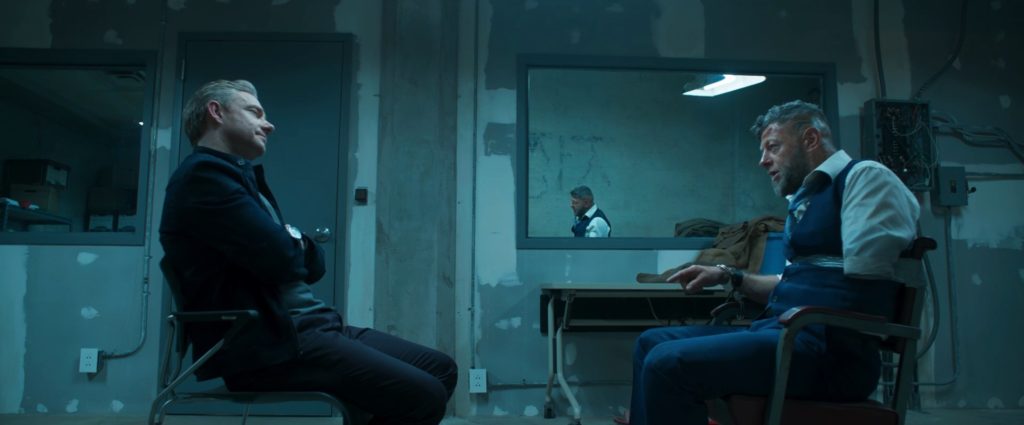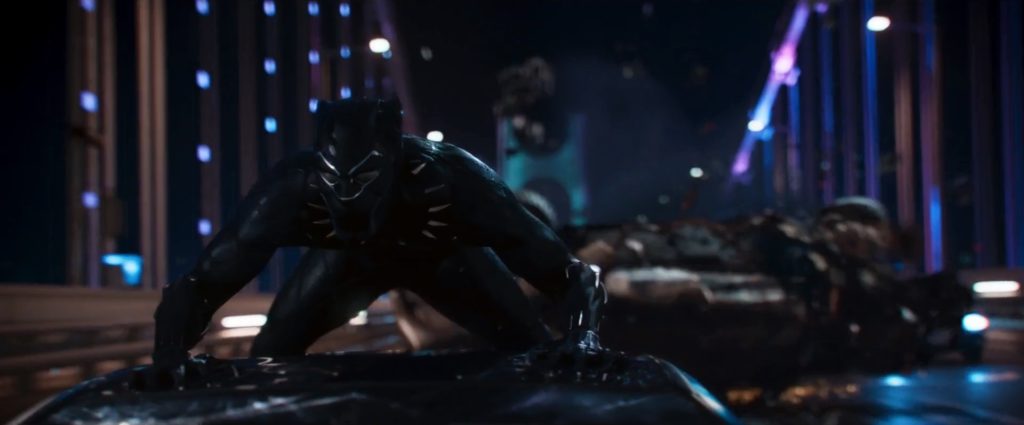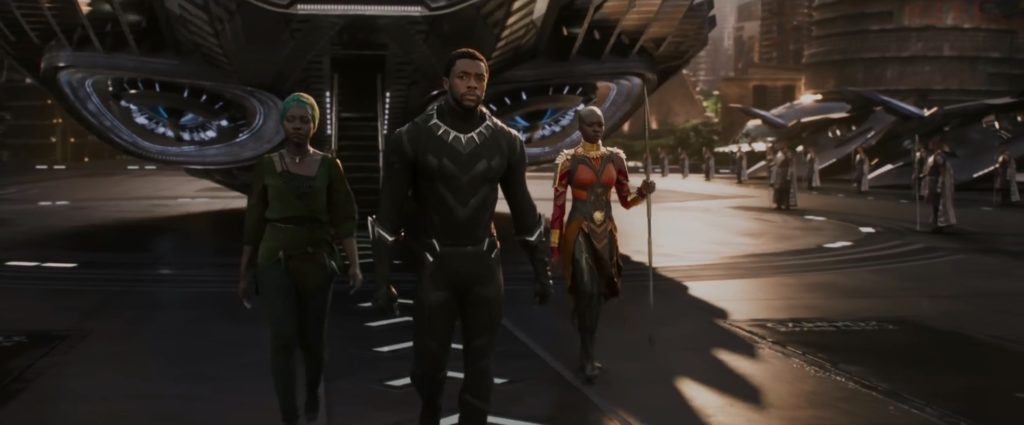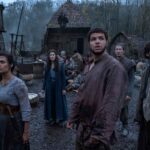In this weekly series, we chronicle the long road undertaken by the Marvel Cinematic Universe movies to arrive at Avengers: Infinity War. We introspect and discuss the movies from a critical and commercial standpoint while also considering the development efforts that went behind them. These articles may be occasionally sprinkled with spoilers so please make sure to skip the relevant sections when reading.
This post is about the 2018 movie Black Panther, the eighteenth chapter in the Marvel Cinematic Universe. To check out other entries in our Road to Infinity War series, click here.
Superhero movies are generally large in action and spectacle. Each successive installment harbors ambition to top what went by. Unfortunately, some are so consumed by the burden of living up to the action, they frequently forget that all of it will appear aesthetically pleasing but eventually hollow material to the viewer without a substantial plot and meaningful characters to root them beneath. In their attempts to overcome the audience with awe, they leave their plots and characters awfully undeveloped.
This of course, is far from the truth with Marvel Studios’ latest outing Black Panther. On the contrary, it appears Ryan Coogler’s black superhero flick makes no attempt to topple any of prior Marvel’s attempts at creating what amounts to spectacular superhero visuals, but instead sticks to the good old days of telling a story that in many ways, mirrors real world happenings in an almost allegorical sort of way. In that sense, it sparks debates and ignites conversations over what it means to be a lead actor of a different color, the issue of immigration and the importance of shying away from stereotypes, as Coogler does when depicting a culture that has been hammered down with cliched portrayals among several others.
Black Panther then, is as much of a superhero movie as Titanic is a disaster movie. Sure, the heroics are there along with the comic lore, legend, mantle and powers of the Panther but the movie uses these as a guise to tell a fictional story that we all wish were desperately true. The said tale involves a fictitious nation of Wakanda, built upon the substance Vibranium and African culture, that has been hiding in the shadows for long. Having successfully projected itself as a third-world country, Wakanda has secretly built itself as a technologically advanced nation, where warriors fight to protect the country from invaders that threaten to spill its culture and corrupt its morals, where women are as savvy in tech and science as they are in war and fighting, where the rich vistas and heritage are protected and prosper courtesy the gifted mineral bestowed upon the nation, and where the existence of a King incites external threats and family drama over royal lineage. To counter these threats, the King of Wakanda is not a feasty 200-pound giant, but instead a warrior who wears the mantle of the Black Panther.
The Black Panther has existed in Wakanda for centuries now, pretty much since the country was formed. Specially grown herbs when ingested, give the Panther peak human powers and abilities which he then uses underneath the Vibranium suit to protect the people of Wakanda from foreseen or unforeseen threats. A regal ceremony held over the mountains sees the mantle challenged, with fights arranged for the winner to be crowned King and Panther. The superhero then is as much a part of Wakanda as its people and is coronation is subsequently deeply rooted in Wakandan traditions and customs. Siding with the Panther is an army of badass all-female warriors, the Dora Milaje who fight more swiftly than any of HYDRA’s goons.
 But of course, power invites challenge, in this case, in the form of Erik Killmonger and Ulysses Klaue. Killmonger, who is often declared one of Marvel’s better villains, has his past in Wakanda that he believes, makes him as much worthy of the throne as T’Challa himself. But his motivations for becoming King go much further; having been at life’s crossroads and seen how people of his color are treated, he intends to start a revolution by empowering the oppressed with weapons so they can overthrow their oppressors. That of course means revealing Wakanda’s truth to the outside world, which together with his maniacal plans, puts him at odds with T’Challa. Despite the aggressiveness of his plan, it’s hard to fault his internal logic for simply wishing a more equal life for people like him, which is what makes the central conflict interesting. Klaue assumes the more maniacal personality here, the chaotic nutty wack-job who intends nothing but to inflict harm and cause damage and destruction.
But of course, power invites challenge, in this case, in the form of Erik Killmonger and Ulysses Klaue. Killmonger, who is often declared one of Marvel’s better villains, has his past in Wakanda that he believes, makes him as much worthy of the throne as T’Challa himself. But his motivations for becoming King go much further; having been at life’s crossroads and seen how people of his color are treated, he intends to start a revolution by empowering the oppressed with weapons so they can overthrow their oppressors. That of course means revealing Wakanda’s truth to the outside world, which together with his maniacal plans, puts him at odds with T’Challa. Despite the aggressiveness of his plan, it’s hard to fault his internal logic for simply wishing a more equal life for people like him, which is what makes the central conflict interesting. Klaue assumes the more maniacal personality here, the chaotic nutty wack-job who intends nothing but to inflict harm and cause damage and destruction.
There’s something to be said about the amount of strong female characters the movie embodies. There’s Okoye, who leads an all-female army of warriors that fight commendably in fight sequences choreographed to bring out the elegance and brutality of their moves. Even though their sworn duty is to protect the King and the Nation at all costs, Danai Gurira infuses some personality into Okoye and her swift swishing and slashing maneuvers lend a credibility to her status as the leader of the Dora Milaje. There’s T’Challa’s sister Shuri, the young but exceptionally brilliant science kid who shares a dynamic with T’Challa evocative of one between Bond and Q. Far from being relegated to the backseat, Shuri takes center-stage, upgrading the Panther’s suit to allow absorption of kinetic energy, and is generally in the driving seat for most of the film as far as matters of tech and the science behind the suit goes. There’s Queen Ramonda, who leaves an impact in her small role and provides the support system T’Challa desperately needs after losing his father in Civil War. Rather than drown in the sorrows of her husband’s death, she overcomes the setback and encourages her son to succeed his father and assume responsibility as the ruler of Wakanda. There’s Nakia, T’Challa’s ex, and a capable fighter in her own right. Clearly the movie is far more female-centric that you’d otherwise believe and seeing this in a movie, watching a powerhouse of women of color kick ass instead of being delegated to the backseat, defies all stereotypical expectations one would have from female actors in a movie of this scale, and is one of the many areas where Coogler broke new ground.
Much has been made of the political undertones underlying the central narrative, and I even discussed them in detail in my original review. The debate between W’Kabi and T’Challa for instance, who argue in favor of and against doing more for people outside by letting them in, evokes a similar parallel in the real world situation of refugees and immigration challenges. Wakanda itself, as a nation with access to technological resources, restricting itself from helping the external world combat its challenges is a subtle mirror to the United States, and whether it should be doing more to help the underprivileged nations or stay out of the conflict. Such is the impact of Killmonger’s challenge that despite being defeated by T’Challa eventually, the King of Wakanda actually adapts and accepts the genesis of his plan, molding it into an appearance and subsequent announcement at the United Nations that makes Wakanda public in a vital mid-credits scene that almost seems like a part of the movie itself (which it earlier was).
 Everybody brings their A-game to the table, whether its cinematographer Rachel Morrison working in tandem with Visual Effects Supervisors from Industrial Light & Magic Geoffrey Baumann, Craig Hammack and Dan Sudick among others to capture breathtaking visuals in Wakanda from the Panther statue, to the sepia toned mountains, to the Jabari tribe’s snowy lairs and effectively taking us on a tour of Wakanda through the story, or whether its the tight editing by Michael Shawer and Claudia Castello that keep the movie’s run time contained while yet allowing for an expansive story to be told. Costume Designer Ruth Carter imbues every person, tribe or race with a distinctive look that’s at once colorful and detailed, effectively giving Wakanda its own sense of fashion.
Everybody brings their A-game to the table, whether its cinematographer Rachel Morrison working in tandem with Visual Effects Supervisors from Industrial Light & Magic Geoffrey Baumann, Craig Hammack and Dan Sudick among others to capture breathtaking visuals in Wakanda from the Panther statue, to the sepia toned mountains, to the Jabari tribe’s snowy lairs and effectively taking us on a tour of Wakanda through the story, or whether its the tight editing by Michael Shawer and Claudia Castello that keep the movie’s run time contained while yet allowing for an expansive story to be told. Costume Designer Ruth Carter imbues every person, tribe or race with a distinctive look that’s at once colorful and detailed, effectively giving Wakanda its own sense of fashion.
Every single actor plays their part triumphantly whether it’s the lead T’Challa by Chadwick Boseman, or a relatively small role as his aide undertaken by Forest Whitaker. Boseman pulls off the extremely difficult Xhosi inspired Wakandan language flawlessly; it’s hard to believe him speaking fluent English in interviews promoting the film. His nemesis, Erik Killmonger, played with a finesse and subtlety by Michael Jordan, tries and lends a gravitas to the villain, often making us sympathize with his situation, never mind the dangerously rebellious nature of his plan. Danai Gurira is strong and fierce as Okoye, almost coming off as T’Challa’s equal in battle. Leticia Wright adds enough spunk and attitude playing T’Challa’s sister Shuri, enough to inspire young girls into taking up science. Lupita Nyong’o as Nakia is as convincing as Andy Serkis is menacing in Ulysses Klaue. And even though Martin Freeman’s Everett Ross is still delegated to the backseat, he brings in enough of his charm to make the character his own with his quirky demeanor.
As the movie steadily built up towards its release, anticipation surrounding it grew fervently. While the trailers had already garnered enough applause and appreciation to herald this as something special, by the time the movie opened, it had built up to unimaginable expectations. And perhaps even more astoundingly, Black Panther delivered, beyond the wildest hopes of what everyone had thought it would. It ended up with an opening weekend figure of $200 million in the US that extended to $240 million on President’s Day weekend and before we knew it, inched globally as well as domestically to exceed everyone’s projections. It steadily marched ahead of $500 million and before we knew it, it ended up grossing $1.3 billion worldwide with $683 million of that coming from the United States. That domestic gross makes it only the third highest grossing film in the United States behind juggernauts like Star Wars and Avatar; such was its phenomenon that it was able to surpass the generally unbeatable Titanic.
 Critics too showered equal praise on the movie, making it the MCU’s best reviewed movie of all time (a title I believe it will continue to cling-on to for a long while). Appreciating Coogler’s direction, Boseman’s performance, the strong female cast, Jordan’s play as Killmonger and a story that had political ramifications and resonated rightly with colored people with a climax that opened up the doors to the generally poorly depicted community, Black Panther went on to win huge acclaim that was unparalleled in any movie’s history off late. Some even suggested the movie as a strong contender at the Academy Awards in some respect, an agenda with Marvel would be wise to push once the awards season nears next year.
Critics too showered equal praise on the movie, making it the MCU’s best reviewed movie of all time (a title I believe it will continue to cling-on to for a long while). Appreciating Coogler’s direction, Boseman’s performance, the strong female cast, Jordan’s play as Killmonger and a story that had political ramifications and resonated rightly with colored people with a climax that opened up the doors to the generally poorly depicted community, Black Panther went on to win huge acclaim that was unparalleled in any movie’s history off late. Some even suggested the movie as a strong contender at the Academy Awards in some respect, an agenda with Marvel would be wise to push once the awards season nears next year.
And so, we come to the end of our long ongoing Road To Infinity War. We’ve seen it all, from the humble beginnings of Tony Stark as a man in an Iron Man suit, to the legend of Captain America being brought back to present day, from Gods like Thor and monsters like Hulk wreak havoc and from the minuscule origins of a hilariously named Ant-Man to the mystical arts and sorcery of Doctor Strange. We’ve seen the Guardians of the Galaxy save the universe multiple times and we’ve seen Avengers team up to fight Loki and Ultron before parting ways amidst their own Civil War, we’e seen new players enter the foray as Spider-Man and Black Panther, and we’ve seen new locations like Wakanda introduced that will go on to play a much bigger role in the wars to come. For now, the floodgates have opened. All hell will break loose. With the major forces of Odin, Ego and Hela gone, there’s nothing to stop Thanos from laying his claim over the Infinity Stones. Except of course, the Avengers should they be able to keep aside their squabbles and team up together to save what amounts to destruction of half the universe.
The story continues in theaters with Avengers: Infinity War on April 27. Thanks for Reading.





